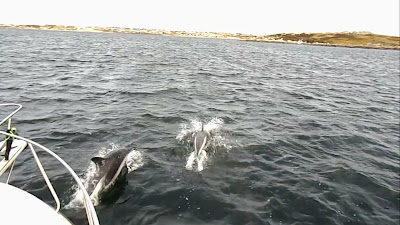We are writing these
lines in mid-air above the South Atlantic – outside, everything has been in
shades from dark blue to white since we took off from Ascension Island 3 ½
hours ago, with no traces of land or any form of human activity since then: No
ships, no other aircraft, not even contrails! This will continue for another 5
hours. A true ocean planet, and a stark reminder that mankind is restrained to
occupying only a small proportion of this planet’s surface.
Two members of our
team are already in the Falklands and waiting for us – Pieter, Frithjof’s
friend and collaborator from Aberdeen, and Alexandra, their joint PhD student.
Ascension has become a
favourite stopover with unparalleled tropical diving experiences in some of the
most fish-rich waters of Planet Earth on the way to or back from our South
Atlantic and Antarctic expeditions – and more: A comprehensive inventory of the
inshore marine biodiversity and the key ecological features of this remote,
rocky outpost of the UK, somewhat half-way in the South Atlantic between Angola
and Brazil were the objective of an expedition of the Falklands’ Shallow Marine
Surveys Group (SMSG - http://smsg-falklands.org/) in August-September 2012 , to which our friend
Kostas Tsiamis (HCMR, Athens) and Frithjof’s algal research group at Aberdeen
and contributed an up-to-date seaweed survey with 39 new records of taxa
previously unknown from this part of the world. As we were amazed to realize
during our latest visit to Ascension, this expedition is being commemorated in
a series of special issue stamps of the Ascension Island Postal Service! This sure does not
happen to many scientists and their explorations.
Once more, we had an awesome and rewarding
time here. On the scientific side, we collected a number of coralline red algal
samples which will enable reconstructing Ascension’s past marine environment in
the lab of our friend and colleague Nick Kamenos (Univ. Glasgow - http://www.gla.ac.uk/schools/ges/staff/nicholaskamenos/). This was Melina’s 1st
and Frithjof’s 4th visit to Ascension, and we sure made the most out
of our time there. Thanks to Caz Yon’s and the Ascension Conservation
Department’s friendship and hospitality, we were able to conduct 4 dives,
including one at English Bay and the Lava Tunnels, two at the remote Boatswain
Bird Island off Ascension’s NE coast and another one at Red Rock Cave, a
spectacular sea cave. On the way back from Boatswain Bird Island to Georgetown
harbor, we encountered a pod of approx. 8 bottlenose dolphins (Tursiops truncatus) – we got the
captain, the South African Craig, to stop the boat, jumped into the water and
spent about half an hour snorkeling with them! It was truly amazing and
breathtaking. In their innocent curiosity, the dolphins kept coming back to us,
over and over again, up to just over a meter away from each of us, making their
presence known by whistling and jumping out of the water.
Due to its unique geographical location,
Ascension has long been a favorite site for installing all kinds of
transmission and tracking antenna systems – including the South Atlantic Relay
Station of the BBC (providing BBC radio to a large part of the southern
hemisphere) and several monitoring stations for rockets and missiles. Among the
latter is one of four monitoring stations of rockets launched from Kourou,
French Guyana – mostly Ariane V rockets these days, but in recent years also
increasing numbers of Soyuz rockets. This is Caz Yon’s and Nick John’s work
place – visiting it was a very memorable event for us.
Leaving this peculiar
and interesting island behind, flying to the Falkland Islands and continuing
our research expedition, we bring to mind the unique picturesque appearance of
the land, with its lava structures, wild environment with red and black sand
and rocks down to the seashore. The Green Mountain sits on its own, as a
reminder of the power of nature to give life, although the first trees and
plants where introduced following a suggestion by Darwin. It will be
interesting to see how the island will change as years pass and the plants
colonize the nearby mountains.
Its white long
beaches, provide the perfect nesting habitat for the Green Turtle (Chelonia mydas), which comes in
thousands every year, with 2012 being the record year so far (over 17,000
nests)! The spectacular geological features of this island continue into the
sea, providing a unique substrate for the marine life – thousands of eels,
millions of black fish, crabs, turtles, dolphins and other Atlantic fish find a
hospitable home in this remote area…
Finally, a footnote on how we travel in
this part of the globe. No regular
civilian airlines serve Ascension – passengers can only get there on some
flights of the RAF, USAF, or with the Royal Mail Ship St. Helena. “Our” aircraft is a
military version of the Airbus A330 – a dual-use, wide-body passenger aircraft
which has large extra fuel tanks and refuelling pods under the wings for
refuelling other aircraft in mid-air (operated by AirTanker, a contractor to
the UK’s Royal Air Force / Ministry of Defence). In-air refuelling has long
been critical for transferring other aircraft (especially Hercules cargo planes
and fighter jets) to the UK’s military base in the Falklands – especially for
the long haul from Ascension to the Falklands.
Melina Marcou and Prof. Frithjof Kuepper
Prof Frithjof Kuepper






+090.jpg)
+109.jpg)
+349.JPG)
+369.JPG)
+443.jpg)
+460.jpg)
+568.jpg)
+623.jpg)





